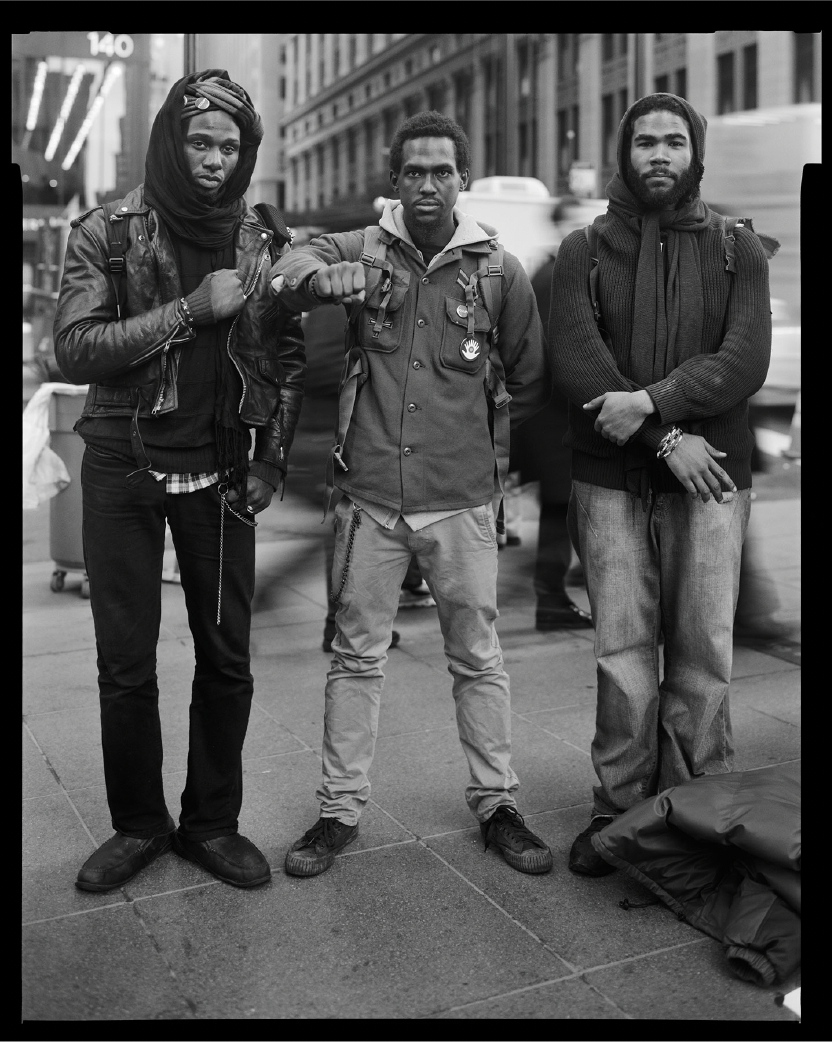Courtesy of the artist and Von Lintel Gallery
“Blues People has always meant a great deal to me. It was a dramatic self-confirmation, as a personal intellectual and artistic ‘presence,’ but also as the expression of a set of ideas and measures that I have carried with me for many years. Most, even until today.” —Amiri Baraka
Inspired by the 60th anniversary of “Blues People: Negro Music in White America”,—the acclaimed book by writer, poet, political activist and Newark native LeRoi Jones, who later renamed himself Amiri Baraka—visual artists Derrick Adams, Adama Delphine Fawundu, Adebunmi Gbadebo, Cesar Melgar, and Accra Shepp have reimagined pivotal works of theirs to create five newly commissioned art installations at Express Newark that explore what it means to be a “Blues People” in the twenty-first century.
Accra Shepp’s “Occupying Wall Street” and “Covid Journals” feature black-and-white portraits of protesters during New York City’s Occupy Wall Street movement of 2011 and the global Black Lives Matter uprising of 2020. Installed on the main floor of the building and incorporating Baraka’s poetry and the music of Shepp’s father, the avant-garde jazz musician Archie Shepp—a good friend of Baraka’s—Shepp’s work dissolves the boundaries between the individual and the collective, reminding us that those who participated in the demonstrations played an essential role in the safeguarding of American democracy and achieving radical forms of justice.
In the Window Gallery, multimedia artist Adebunmi Gbadebo features two new handmade, site-specific paper textiles inspired by her work “At the Bottom of the Atlantic Ocean There is a Railroad Made of Human Bones.” Taking its title from a line in Baraka’s poem “Wise, why’s, y’s,” her pieces are made from Black hair, cotton, and indigo dye and meditate on labor, land, and familial legacy at True Blue Plantation, the rice and indigo plantation where her ancestors were enslaved in Fort Motte, South Carolina.
Across from these textiles, in the Box Gallery, photographer and visual artist Adama Delphine Fawundu revisits her experimental short film, “Who We Be”, which explicitly takes up Baraka’s emphasis on Black music by exploring hip-hop, social language, and activism in Freetown, Sierra Leone, in West Africa. Serving as a backdrop to the film, “Who We Be II” is a wallpaper designed using Fawundu’s technique, kpoto patchwok, in which she blends photographic transfers of Black crowds throughout the African diaspora, further expanding the musically immersive experience of her installation. In the Mende and Krío cultures of Sierra Leone, the term kpoto loosely translates to “gathering.”
In the Paul Robeson Gallery, multidisciplinary artist Derrick Adams plays with the real estate term protesting gentrification, by reimagining “The Holdout,” a house-like social sculpture with a curated radio station that he initially exhibited at Alijira: A Center for Contemporary Art in Newark in 2015. Experimenting with the format of a pirate radio station and live guest DJ sets, Adams highlights conversations with renowned artists and local activists about displacement, economic development, and land ownership.
Surrounding Adams’s sculpture is street photographer Cesar Melgar’s “Newark Master Plan,” a debut series of black-and-white images of Newark properties from 2019 to 2022 that bear “Notice of Public Hearing on Proposed Development” banners. Exhibited alongside his photos from his 2018 “Street Views” series, set in the Ironbound and Downtown Newark, Melgar’s romantic images remind us of the vitality and vibrancy of Newark communities and the increasing threats posed by higher living costs, corporate home purchases, and the enduring wealth gap.
The “Sounds of Newark” installation displays five works from Express Newark’s Community Media Center residents Laïssa C. Alexia, Kendra Brandon, Gary Campbell, Celli Pitt, and Chris Simmons on the fourth floor. Considering silence as a marker of gentrification, the installation presents a soundscape in which these five artists remember the value of their community as the city changes around them. Working with artist Jamilah Malika Abu-Bakare, these CMC residents use sound as a sonic space of refusal and a creative way to rescue an archive. Taken together, the installation asks: What sounds shall we save?
“Blues People” is curated by Alliyah Allen, Express Newark’s associate curator and program coordinator. Additional support is provided by executive director Salamishah Tillet; creative director Nick Kline; Anonda Bell, director of the Paul Robeson Galleries; Brooke Finister, program coordinator of New Arts Justice; and Anthony Alvarez, assistant director of Shine Portrait Studio and coordinator of the Free School at Express Newark.
Rutgers University-Newark, the Ford Foundation, the Andy Warhol Foundation, the HarbourView Equity Foundation, the Devils Youth Foundation, and Duggal Visual Solutions provide generous funding for this exhibition. Additional support is from New Arts Justice, Shine Portrait Studio, Paul Robeson Galleries, and Harmony Lab.
Additional Information about the exhibition and programs can be found at Express Newark.
